4
Health and Safety in the Dental Workplace
- health and safety requirements relevant to both employers and employees
- the legislative and regulatory requirements of the dental workplace and its staff
- risk assessment in the dental workplace
- occupational hazards and their avoidance in the dental workplace
- the actions to take in various first aid scenarios
- general safety and security issues in the dental workplace
Health and Safety at Work Act (1974)
All dental workplaces, their staff and patients are covered by the provisions of the Health and Safety at Work Act (1974), as is any other workplace. In addition, other legislation is relevant to the dental workplace due to the potentially harmful nature of the equipment and chemicals used, as well as the occupational hazards associated with delivering dental treatment or working in the dental environment.
The Health and Safety legislation seeks to protect staff and patients while on the premises by making the staff aware of any potential hazards at work, and encouraging them to find the best ways of making their premises safer for all concerned. In legal terms, the employer has a statutory duty to ensure that, as far as is reasonably practicable, the health, safety and welfare at work of all employees and all visitors (including patients) are considered at all times. To do this, all the potential hazards first need to be identified, and then the likelihood of them actually causing harm to anyone must be determined. The chance that a particular workplace hazard could cause harm to someone is known as its risk, and the correct procedure to be followed by the employer (and their staff) to identify those hazards that could cause harm is called a risk assessment.
Compliance with the Health and Safety at Work Act is overseen and regulated by the Health and Safety Executive (HSE). This is a government body that provides guidance to employers on the correct enforcement of the Act, and investigates when any serious incidents occur in any workplace where someone suffers serious harm or is killed. Every dental workplace is required to be registered with the HSE.
Compliance with the additional legislation specific to the dental workplace is also required by the General Dental Council, under its Standards for Dental Professionals documentation.
To comply with the basic requirements of the Health and Safety at Work Act, every employer in the dental workplace must abide by the following requirements.
- Provide a working environment for employees that is safe, without risks to health, and adequate with regard to facilities and arrangements for their welfare at work.
- Maintain the place of work, including the means of access and exit, in a safe condition.
- Provide and maintain safe equipment, appliances and systems of work.
- Ensure all staff are trained in the safe handling and storage of any dangerous or potentially harmful items or substances.
- Provide such instruction, training and supervision as is necessary to ensure health and safety.
- Review the Health and Safety performance of all staff annually, be aware of and investigate any failures or concerns highlighted, when they occur.
- Display the official Health and Safety poster for all staff to refer to (Figure 4.1).
To comply with these statutory obligations, dentists must keep their staff informed of all the safety measures adopted. Practices with five or more employees must produce a comprehensive Health and Safety policy and provide all staff with a copy. The policy will classify the practice Health and Safety procedures and name the persons responsible. It should also list the telephone numbers of all dental, administration and equipment maintenance contractors, the local HSE contact, and emergency services.
Role of the dental nurse
All dental nurses have a legal obligation to co-operate with their employers in carrying out the practice requirements in respect of these safety measures. They are designed to protect not only the staff and patients, but anybody else using or visiting the premises. In a large dental workplace, a dental nurse may be appointed as safety representative under the Act for the purpose of improving liaison within the practice about Health and Safety matters.
However, many dental nurses begin their careers as young trainees in the dental environment, so the following two sets of regulations are specifically important in protecting their welfare.
- Health and Safety (Young Persons) Regulations 1997
- Management of Health and Safety at Work Regulations 1999
Figure 4.1 Health and Safety poster.© Crown Copyright 2009. Published by the Health and Safety Executive (HSE).
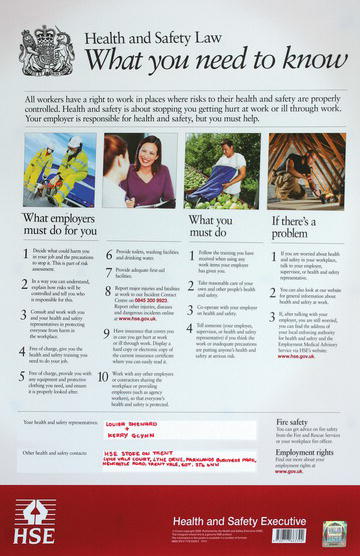
These sets of regulations dictate that a risk assessment of the dental environment has to be carried out, with particular regard to the protection of younger staff members, by taking into account the following points.
- The risks to young people before they start work.
- The psychological or physical immaturity and inexperience of young people.
- Their lack of awareness of existing or potential risks to their health and safety.
- The fitting and layout of the practice and surgery, with regard to the safety of young people.
- The nature, degree and duration of any exposure to biological, chemical or physical agents within the work environment.
- The form, range, use and handling of dental equipment.
- The way in which processes and activities are organized.
- Any Health and Safety training given, or intended to be given.
A summary of the risk assessment details, covering the various types of work activity that a student dental nurse is likely to undertake, to ensure their safety in the dental workplace is shown in Table 4.1. The risk assessment should take into account the likely activities that the student dental nurse will undertake while on the premises, and these are listed in the first column. To train effectively, they must always be involved in chairside assisting activities, so the potential areas of risk to the student during chairside working should then be considered – these are listed in the second column. The final column then needs to identify the methods required to ensure that the student is not exposed to these risks in the first place, and for each area it can be seen that suitable induction training is always required. This involves explaining why a certain activity is a risk to them, the provision of suitable training in the activity so that the risk is minimised as far as possible, and initial supervision when the activity is carried out for the first few times. Before dental nurses became registrants with the General Dental Council (GDC), and therefore before training and qualification were necessary, this supervision used to be referred to as ‘shadowing’ of a junior colleague by a senior colleague, until they were deemed able to carry out the activity unsupervised. The risk assessment procedure described here merely formalises the technique of shadowing.
Table 4.1 Risk assessment for student dental nurse
| Work activity | Potential risk | Prevention with controls |
| Chairside assisting | Eye injury from projectiles during treatment Inhalation of aerosols during treatment |
Explanation of risks, training in activities undertaken, initial supervision Provision and use of all personal protective equipment (PPE) |
| Instrument decontamination | Inoculation injury (clean or dirty) Contamination splash during cleaning |
Explanation of risks, training in cleaning methods, initial supervision Additional PPE – plastic apron and thick rubber gloves |
| Use of autoclave | Burns from hot machine or instruments Scalds from steam |
Explanation of risks, training in handling methods, initial supervision |
| Exposure to hazardous chemicals | Inhalation of vapours, skin contact, eye contact | Explanation of risks, training in handling methods, initial supervision Provision and use of full PPE Adequate ventilation |
| Use of x-rays | Accidental exposure to x-rays | Explanation of risks, inform of designated control area, avoid unauthorised entry to area |
Full compliance with Health and Safety legislation for all dental workplaces, whether a practice, a clinic or a hospital department, involves all of the following.
- Fire Precaution (Workplace) Regulations (1999)
- Health and Safety (First Aid) Regulations (1981)
- Control of Substances Hazardous to Health (COSSH) (1994)
- Reporting of Injuries, Diseases and Dangerous Occurrences (RIDDOR) (1995)
- Environmental Protection Act (1990)
- Special Waste and Hazardous Waste Regulations (2005)
- Ionising Radiation Regulations (IRR) 1999
- Ionising Radiation (Medical Exposure) Regulations (IR(ME)R) 2000
- Occupational hazards
- General safety measures
- General security measures
Since 2010, additional regulations have been introduced in the specific areas of decontamination and infection control in the dental workplace, although their implementation currently varies throughout the UK. Referred to collectively as HTM 01-05, their detail is discussed in Chapter 8. Finally, since 2011 a system of mandatory registration with the Care Quality Commission (CQC) has been introduced for all providers of health and social care, including all dental workplaces. The CQC is a regulatory body which ensures that all registrants comply with essential standards of quality and safety when dealing with patients. The impact of CQC registration on the dental workplace, and its relevance to dental nurses, is discussed more fully in Chapter 3.
Risk assessment
As stated above, the whole purpose of the Health and Safety legislation is to protect everyone within the dental workplace (staff, patients and visitors) from coming to any harm while on the premises. This is achieved by carrying out a risk assessment of every potential hazard that could occur. The aim is not necessarily to eliminate every risk completely (this is likely to be impossible in most workplaces, including dental surgeries) but instead to minimise those risks identified as far as possible, so that there is little chance of them causing harm to anyone.
For example, various chemicals must be used in the dental workplace to carry out dental treatment successfully – these include decontamination solutions, x-ray processing solutions, and mercury in amalgam fillings; all are potentially harmful but only if mishandled. So knowledge of their correct storage and usage by staff, and protection from misuse by all others, are key factors in avoiding a hazardous event.
The steps involved in carrying out a risk assessment on a hazard, whatever its nature, should always follow the same pattern.
Although specialist knowledge of some hazards in the dental workplace is necessary to fully realise their potential for causing harm, many of the actions that should be followed to ensure the health and safety of everyone on the premises are common sense.
Table 4.2 Avoidance of hazards
| Scenario of potential hazard | Common-sense actions to avoid harm |
| Injury sustained by falling down on the premises | Keep all access routes clear of debris and blockages Maintain floor covering adequately Avoid cleaning during work time Clear all spillages immediately Use hazard signs to highlight potential sources of injury (Caution – wet floor, etc.) |
| Child drinking harmful chemical | Keep harmful chemicals out of reach Keep chemicals in locked storage area Keep children out of storage area Keep children under control at all times |
| Person falling out of window on premises | Install window locks Install restricted opening device Keep staff-only areas locked |
| Injury sustained from slammed door | Keep doors locked when rooms not in use Install slow closure devices to prevent slamming Install safety glass |
Consider the scenarios and relevant common-sense actions in Table 4.2. The table gives examples of various hazardous situations that may be encountered by patients and visitors to the dental workplace in the first column, in a similar way to those that may be encountered by the student dental nurse shown in Table 4.1. The second column then suggests common-sense actions to take that will minimise the potential risk in the first place. So, for example, there are several potentially harmful chemicals used in dentistry that cannot be avoided, such as bleach-based cleaning agents. When used for their specific purpose, there is no risk but if used contrary to that purpose (such as being swallowed by a child), their potential to cause harm is huge. The common-sense action is to prevent the child from having access to the chemical at all times, by locking it away in a cupboard or storing it in a locked room away from the public access areas of the workplace. The differing design and layout of each workplace will require that an individual risk assessment is carried out for each one.
These scenarios are not exclusive to the dental workplace – they could occur anywhere at any time and to anyone. However, if they do occur in the dental workplace then they are not merely an unavoidable accident but have become an avoidable risk that should have been prevented from happening. In other words, someone is to blame. If the simple common-sense actions have not been carried out initially, then the employer is to blame. If, however, a risk assessment has resulted in the necessary preventive measures being put into place and someone has flouted them, such as by leaving a door or cupboard unlocked to avoid the inconvenience of having to keep unlocking it, then that person is to blame instead.
All members of staff have a legal obligation under the Health and Safety at Work Act to co-operate with their employer by following the policies and procedures put in place to protect all persons while on the premises. They must also take reasonable care for their own and others’ health and safety while on the premises. Failure to do so, as indicated above, will result in their possible investigation and prosecution by the HSE, and a fitness to practise hearing by the GDC, for those who are registrants.
The level of reasonable care expected to be taken for their own health and safety as an employee (and in line with ‘fitness to practise’ requirements by the GDC) requires all dental care professionals to abide by the following when in the dental workplace.
- Undergo suitable training in the use of dental materials and equipment.
- Always follow that training when using those materials and equipment.
- Always follow all policies in relation to health, safety and welfare issues.
- Never misuse any materials or equipment on the premises.
- In particular, never misuse or fail to use any materials or equipment that are specifically meant to reduce or eliminate hazardous risks.
- Always report any faults in procedures or equipment to a senior colleague immediately.
- Never enter certain designated ‘hazardous’ areas unless authorised to do so.
- Always report any suspected health problem that will affect their normal work to a senior colleague as soon as possible.
It is important, then, that a FULL risk assessment of the dental workplace is carried out and its findings reviewed on a regular basis, and that all staff follow the control measures that have been put into place, at all times. Advice and guidance are available on risk assessment generally, and in the dental workplace in particular, from both the HSE and from organisations such as the British Dental Association. Their website addresses for further information are:
- Health and Safety Executive: www.hse.gov.uk
- British Dental Association: www.bda.org.
Fire Precaution (Workplace) Regulations 1999
The above regulations were updated by the Regulatory Reform (Fire Safety) Order, which became law in 2006. This stipulates that the employer/owner of the premises (the dental workplace) must take reasonable steps to reduce the risk from fire, and to make sure that people on the premises can escape safely if there is a fire. They therefore require the employer/owner to risk assess the fire precautions that are needed for their own work premises, as these will vary from one workplace to another; a ground floor practice will be considered less dangerous to staff and patients in the event of a fire than one that is in a multistorey building, for instance.
A typical fire risk assessment should consider the following points, and in this order.
All dental workplaces then undergo a fire safety inspection, so that the premises can be formally recorded as having carried out the necessary risk assessment. Although several companies provide the means for this to be carried out by post, a visit by a suitably qualified inspector from the Fire Brigade will hold more weight if a fire does occur and the practice is held to account for its level of compliance.
The inspection will give advice with regard to the following.
- The number and positioning of smoke detectors.
- The number and positioning of fire extinguishers.
- Written records of staff training in the use of fire extinguishers.
- The types of fire extinguishers to be provided, with at least two types present in all workplaces.
Fire detection
The Regulatory Reform (Fire Safety) Order 2005 states that an electrical fire alarm system and/or an automatic detection system are only necessary on premises where these devices would be necessary to give warning in case of fire. The types of premises involved would be large workplaces, perhaps over several levels, where a fire breaking out in one area could go undetected by an ordinary smoke alarm or unnoticed by a person for some time. Hospital departments and health clinics are examples of places where these additional fire detection methods would be required.
In smaller workplaces (the majority of dental practices), a fire risk assessment should determine that adequate fire detection is provided by battery-operated smoke alarms around the premises (Figure 4.2). The local fire station, or the fire inspector, will give advice on the number required and their suitable locations at key points throughout the premises. They should be tested on a regular basis to ensure they are functioning correctly, and a record kept of these test dates and results. Obviously, the battery should be changed as soon as it begins to fail, or the alarm changed if any malfunctions occur.
Figure 4.2 Smoke alarm.
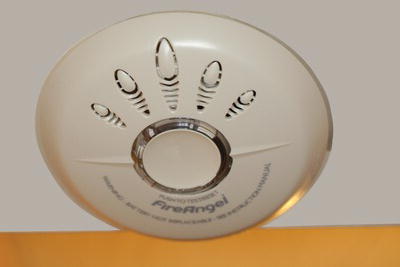
Fire fighting
The main equipment available for use in fire fighting is the fire extinguisher (Figure 4.3), although some premises will have additional equipment such as fire blankets and hoses. To determine which fire-fighting equipment should be available, the classification of fires is considered as follows.
- Class A fire– caused by the ignition of carbon-containing items such as paper, wood and textiles.
- Class B fire– caused by flammable liquids such as oils, solvents and petrol.
- Class C fire– caused by flammable gases such as domestic gas, butane, liquefied petroleum gas (LPG).
- Class D fire– caused by reactive metals that oxidise in air such as sodium and magnesium.
- Class E fire– caused by electrical components and equipment.
- Class F fire– caused by liquid fats such as used in kitchens and restaurants.
In the dental workplace, the likeliest causes of fire shown above suggest that extinguishers to fight classes A, B, C and E should be available. The content of each fire extinguisher varies depending on its recommended use, and is identifiable by a coloured label or specific wording on the label of the extinguisher. All extinguishers are coloured red so that they are easily visible, while the label and its wording describe the fire classification that it is suitable for, as follows.
- Red (water) extinguisher – for use on all except electrical fires.
- Black (carbon dioxide) extinguisher – for use on all fires.
- Blue (dry powder) extinguisher – for use on all fires.
Figure 4.3 Fire extinguisher.
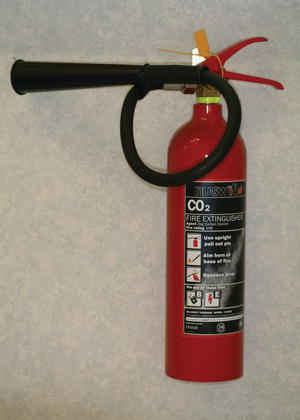
The extinguishers must all be inspected and certificated by a competent person on an annual basis, and replaced as necessary. They should be located:
- within easy reach, ideally along escape routes
- in conspicuous positions (so not hidden by surrounding cupboards, for example)
- on wall mountings and signposted
- in a similar position on each level of the premises.
Evacuation and escape routes
During the risk assessment process, consideration should be given to whether, in the event of a fire, all persons on the premises could leave safely and reach a place of safety. There should be no possibility of anyone being cut off from escaping from the premises by either smoke or flames.
In particular, the following areas of fire safety must be complied with.
- Escape routes must be kept free from all obstructions to allow immediate evacuation from the premises if necessary. In particular, key-operated doors must be kept unlocked during normal working hours.
- Fire exits must lead directly to a place of safety, usually outside the building itself.
- They must be clearly marked by green ‘Fire Exit’ signs, with an accompanying pictogram of a running man (Figure 4.4).
- Emergency lighting should be provided if necessary – this applies to hospitals rather than individual practices, and will have been identified during the fire risk assessment.
- Emergency doors should open manually in the direction of escape, and should not be operated electrically.
- Sliding or revolving doors should not be used as fire exits.
- All staff must be aware of the fire safety and evacuation process, and the procedure for evacuation should be practised at least annually.
- In addition, some staff should be charged with certain actions during the evacuation procedure, such as checking certain areas are clear or closing certain doors to contain the fire.
- Special consideration also needs to be given to the needs of disabled persons, and in small workplaces they should only be treated in ground-floor surgeries so that they can be easily evacuated from the premises.
Figure 4.4 Fire exit pictogram.
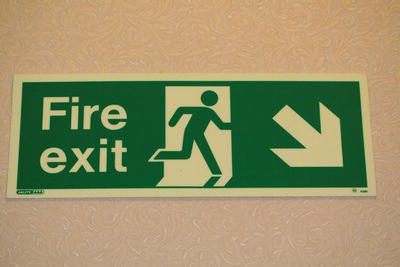
Figure 4.5 Fire escape poster.
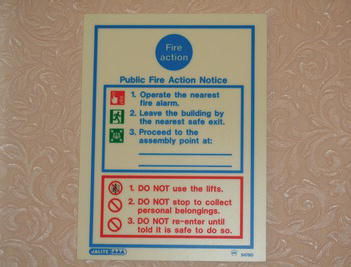
The culmination of the findings from the fire risk assessment will ultimately be the development of a written fire policy or an emergency plan. This is a legal requirement in workplaces with more than five employees, and must be available to all employees and to the fire inspector. It should detail what action everyone on the premises should take in the event of a fire, and may be covered by a simple ‘Fire Action’ poster displayed in the reception area (Figure 4.5). Larger premises will be expected to provide more detail still, and a suitable emergency plan should cover the following points.
- Action to take in the event of a fire.
- Alarm warnings (klaxon, whistle, etc.).
- How to call rescue services.
- Evacuation arrangements, including details for disabled persons.
- Assembly point.
- Method of accounting for all persons (daylist, for example).
- Key escape routes.
- Location and use of fire-fighting equipment.
- Responsibilities of nominated persons.
- Power shutdown methods.
- Staff training.
Smoking in the workplace
Smoking in all enclosed workplaces is now prohibited throughout the UK. All enclosed workplaces, which include all types of dental workplace, must display a ‘No Smoking’ sign at each entrance (Figure 4.6) and the sign must contain the following wording: ‘No smoking. It is against the law to smoke in these premises’. Before the ban, careless disposal of cigarettes was a significant cause of fires in the workplace, so future analysis of fires and their causes will hopefully show a reduction in their incidence.
Figure 4.6 ‘No Smoking’ sign.
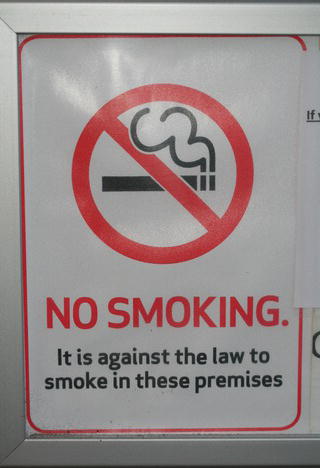
Health and Safety (First Aid) Regulations 1981
In addition to the identification of the signs and symptoms of the medical emergencies that may occur in dental practice and their correct management (see Chapter 6), the whole dental team should be able to deal with basic first aid procedures too.
Under the First Aid Regulations, all workplaces must have adequate first aid provision available for all employees, although there is no legal requirement to provide first aid treatment and facilities for non-employees, including patients.
The risk assessment process carried out to comply with general Health and Safety requirements should identify the hazards and risks associated with the workplace itself, and the occupational hazards associated with the business of dentistry. The hazards and risks identified will determine the extent of the first aid provision that is required for the premises and the employees.
In line with clinical governance guidelines (see Chapter 3), every practice must comply with the following requirements.
- All staff must be trained and certificated in basic life support (see Chapter 6).
- All workplaces with more than five employees should have at least one person trained in emergency first aid.
- All practices must have a first aid kit available, besides the full range of emergency drugs and emergency oxygen cylinders required under clinical governance guidelines.
- All practices must have an accident book, which is used to record all except major accidental events that occur on the premises to staff, patients or visitors.
- In the event of a medical emergency, the dental team must be able to reassure and help the casualty until the professionals arrive, and this may include basic life support (BLS) to maintain life if necessary.
Figure 4.7 First aid box.
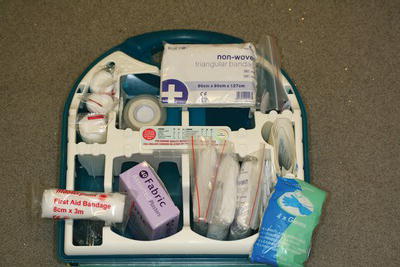
The first aid kit that must be present in the dental workplace should be placed in an easy-access and signposted location. Regulations stipulate that it should be a green box with a white cross on (Figure 4.7), and should contain minimum requirements with regard to sterile dressings, eye pads, bandages, etc.
Specific training for emergency first aid is provided by various HSE-approved organisations, including the British Red Cross and St John Ambulance. The first aid emergencies that should be covered are as follows, and are summarised below.
- Severe bleeding
- Burns and scalds
- Poisoning
- Electrocution
- Bone fractures
Severe bleeding
- The first aid principle is to restrict the blood flow to the wound and encourage clotting to reduce blood loss.
- Arterial bleeding will spurt rhythmically and be cherry red in colour.
- Venous bleeding will gush quickly and be dark red or purple in colour.
- Capillary bleeding will ooze slowly and be dark red in colour.
- The required treatment is to raise the injured part above the level of the heart if possible, and apply direct pressure to the wound for up to 15 min using a clean dressing.
- Any foreign objects present should not be removed from the wound.
- As a last resort, severed arteries can be compressed against the underlying bone for up to 15 min, using a tourniquet.
- The casualty should be removed to hospital once the bleeding is under control, or the emergency services should be called if it cannot be controlled.
Possible causes of severe bleeding in the dental workplace include unexpected surgical trauma, traumatic falls, severe sharps injury, etc.
Burns and scalds
- A burn is an injury caused by dry heat, corrosive chemicals or irradiation.
- A scald is a wet burn caused by steam or hot liquids.
- The first aid principles are to prevent infection of the underlying tissues and to prevent clinical shock developing due to the loss of blood serum.
- The required treatment is to remove the casualty from the source of danger if possible, and to reassure them if they are still conscious.
- The injured part should be placed under cold water for a minimum of 10 min, to reduce blistering.
- Any restrictive jewellery should be removed before any swelling occurs, but clothing should be left in place as its removal may causing tearing of the tissues.
- Seek medical help for all but minor burns or scalds, and be prepared to carry out BLS if clinical shock develops in severe cases.
Possible causes of burns in the dental workplace include touching hot equipment or instruments, touching naked flames, various chemicals (etching gel, bleach products, other cleaning agents) and uncontrolled exposure to x-rays.
Poisoning
- The first aid principle is to limit the exposure of the casualty to the poison, and maintain life if necessary.
- Consult any available COSHH documentation for the required first aid advice.
- The required treatment is to remove the casualty from the source of the poison, without endangering other lives.
- Where vapours are the cause, provide good ventilation of the area immediately.
- Vomiting should not be induced, as caustic poisons will burn the digestive tract each time they pass through.
- Maintain the airway and carry out BLS if necessary.
- Seek urgent medical help.
Possible causes in the dental workplace include the ingestion or inhalation of various agents, such as corrosive chemicals (bleach products and acids), toxic chemicals (cleaning agents, processing chemicals, mercury), toxic vapours (processing chemicals, mercury, gases).
Electrocution
- This is caused by an electrical current passing through the body, causing burns and possibly affecting the electrical conduction of the heart itself.
- The first aid principle is to remove the casualty from the electrical source and maintain life until help arrives.
- The required treatment is to isolate the electrical supply if it is safe to do so, treat any surface burns and minimise the effects of clinical shock.
- The casualty should not be touched by the rescuer until the electrical source has been isolated, otherwise the rescuer could be electrocuted too.
- Carry out BLS if necessary.
- Seek urgent medical help.
Possible causes in the dental workplace are any faulty electrical equipment items, including portable appliances.
Fractures
- A fracture is a break of a bone, either contained within the surrounding soft tissues or puncturing through them to cause a compound fracture, where the bone ends are visible and soft tissue damage is severe.
- The first aid principle is to prevent further tissue damage by restricting the movement of the casualty.
- The required treatment is to not move any injured part of the body, to cover any open skin wounds with clean dressings, and control bleeding as necessary.
- Seek urgent medical help.
Possible causes in the dental workplace are external trauma or a fall, although violent assault of a person may also be a cause.
Basic life support techniques and medical emergencies are covered in detail in Chapter 6.
Control of Substances Hazardous to Health (COSHH) 1994
Many of the chemicals and other hazardous substances used in the dental workplace can be harmful to a person’s health if they are misused or if adequate precautions are not taken to prevent access by unauthorised persons. However, without these substances the business of dentistry could not be carried out, so the continued use of the chemicals under safe conditions is the desired outcome. Again, the level of risk from any of the chemicals or substances involved, those who may be harmed and the necessary precautions to take are all determined by carrying out a risk assessment.
The risk assessment process to be followed in this case is determined by the COSHH regulations, which require all dental workplaces to carry out a risk assessment of all the chemicals and potentially hazardous substances used in the premises, to identify those that could harm or injure staff members. Harm may be caused if an accident occurs to expose personnel to an unusually large amount of a chemical, or if a chemical accidentally gains entry to the body (for example, by being inhaled), or merely just by the dangerous nature of even small amounts of a chemical (for example, mercury). The risk assessment process follows the usual steps but the written report produced must include every potential chemical hazard found, and the following specific information.
- The hazardous ingredient(s) it contains.
- The nature of the risk, ideally by indicating the risk category using recognised symbols (Figure 4.8).
- The possible health effects of the hazardous ingredient(s).
- The precautions required for the safe handling of the product.
- Any additional hazard control methods required for its safe use.
- All necessary first aid measures required in the event of an accident involving the product.
Figure 4.8 Symbols of COSHH risk categories.
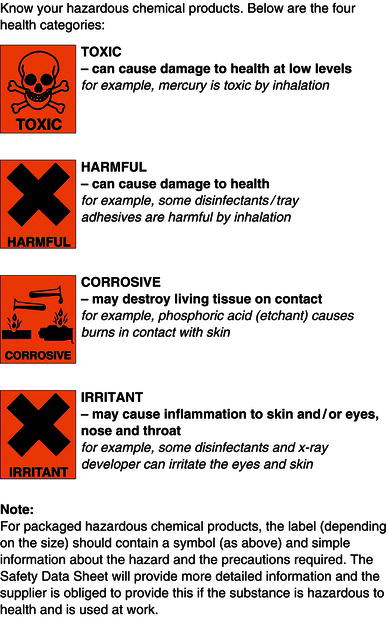
The r/>
Stay updated, free dental videos. Join our Telegram channel

VIDEdental - Online dental courses


